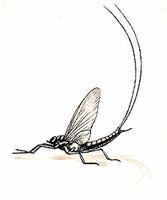
Mayfly is the common name for small, fragile, soft-bodied insects comprising the order Ephemeroptera (from Greek ephemeros, meaning, "living a day," and ptera, “wings”). They may also be called shadflies or occasionally fishflies, but the latter is usually reserved for insects of the order Megaloptera. Over 3,000 species of mayfly are known worldwideand 329 occur in Canada. Common species found throughout Canada include blue-winged olives (e.g., Baetis tricaudatus), speckled duns (e.g., Callibaetis ferrugineus), and hex (Hexagenia limbata). Other species are more common on a regional basis: e.g., Baetis bicaudatus in the West, and the little yellow quill (Leucrocuta hebe) in the East. Mayflies are one of the few surviving orders of insects found in the fossil record that date back to the Carboniferous Period (approx. 320 million years ago). In this period, they had wingspans of up to 45 cm. The oldest mayfly fossil found in Canada is from the Late Cretaceous and was discovered in the Wapiti Formation, southwest of Grande Prairie, Alberta; its age can be estimated at over 70 million years. (See also Geological History.)
Structure
The long, often shiny bodies of mayflies end in two or three long filaments, or tails. The wings are membranous with large forewings and small (sometimes absent) hind wings. Nymphs have feathery gills along the sides of the abdomen through which they obtain oxygen. Mayflies are specially adapted for reproduction, as no energy is wasted on body parts other than those needed to reproduce: adults have reduced, non-functioning mouthparts, as they do not feed, and many species also have reduced legs (except for the elongate male forelegs which are used during mating). Mayflies spend their entire adult lives in flight seeking a mate.
Distribution and Habitat
Mayflies are found worldwide, with the exception of Antarctica, the high Arctic, and a number of isolated oceanic islands. Nymphs occur in a wide variety of freshwater environments, from still ponds to fast-flowing streams. Adults are common near water, but mating swarms can also be found up to 2-3 km away from water, in nearby meadows and forest clearings, and along highways. Mating swarms are most common at dawn and dusk.
Reproduction and Development
Mayflies undergo incomplete or simple metamorphosis, in which juveniles share a resemblance with adults and there is no pupal stage. Eggs are deposited in clean, flowing water. The larval stage is aquatic and lasts a few months to two years, depending on the species. Transformation to the terrestrial stage usually occurs at water surface, where mature nymphs moult into a winged stage called the subimago. This pre-adult stage is unique among insects, and makes mayflies the only group to moult after developing fully functional wings. The subimago, which is relatively hairy and dull in colour, flies a short distance to rest on some vegetation, and moults again within a few minutes to 24 hours, transforming into a sexually mature adult. Adults form large swarming flights of mostly males, and as a female enters the swarm, a male uses its forelegs to grasp onto the female’s body and the two mate in flight. Females lay eggs very shortly afterward (within minutes to hours), depositing them either directly into water or onto objects at or near the surface. Adults do not feed and most live only 1-2 days. In the most extreme example, adults of Ephoron album live only 90 minutes, and females do not even moult past the subimago stage.
Ecology
Mayfly nymphs feed on algae and organic waste, and a few are predatory. Nymphs play an important role in cleaning streams, as they consume contaminants and then later, as adults, carry them to land where they can safely degrade over time. Similarly, mayflies provide substantial ecological services by reincorporating nutrients into the soil once dead (e.g., excess phosphates and nitrates from agricultural runoff). Mayfly nymphs also serve as bioindicators of ecosystem health and quality, since their populations are sensitive to changes in water chemistry.
Both nymphs and adults are very important sources of food for fish, as well as for birds, amphibians, spiders, and other insects. Because mayflies emerge en masse at specific times of the year, providing a feast for fish, numerous species serve as models for fly-fishing lures, which can be so specific as to imitate both the spring and late-summer broods of the same species.
Mayflies are almost never considered pests, although the large swarming flights of newly emerged adults can sometimes be very dense, creating a nuisance due to their sheer numbers.

 Share on Facebook
Share on Facebook Share on X
Share on X Share by Email
Share by Email Share on Google Classroom
Share on Google Classroom



